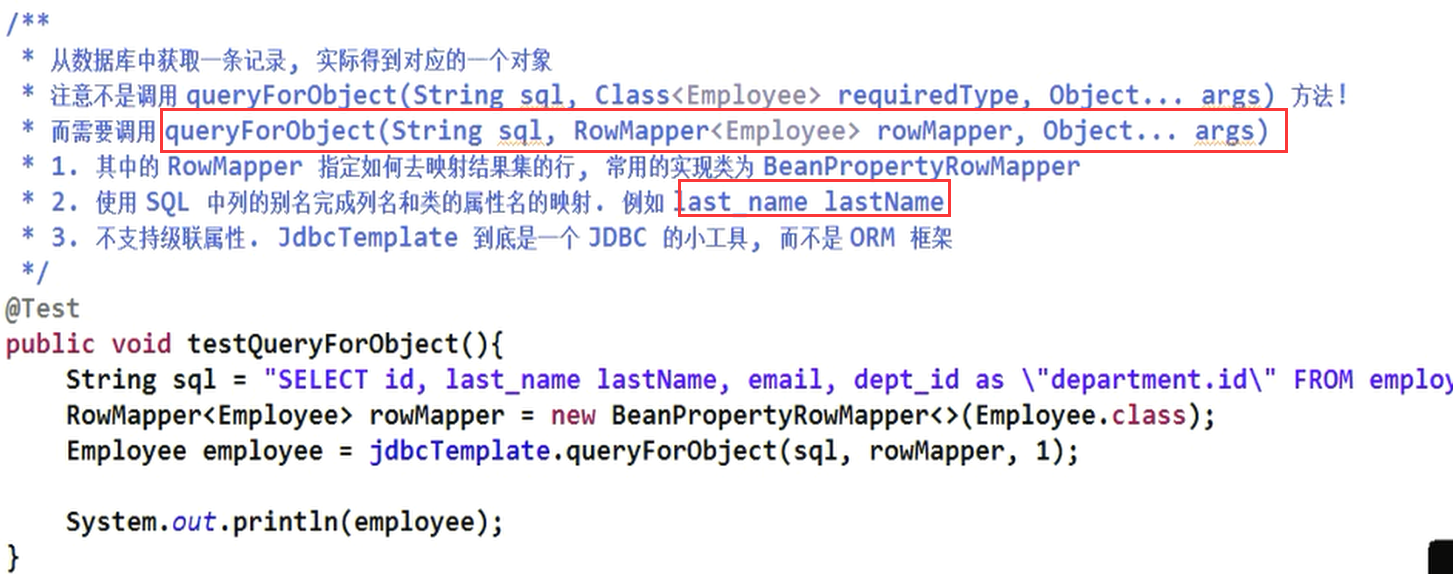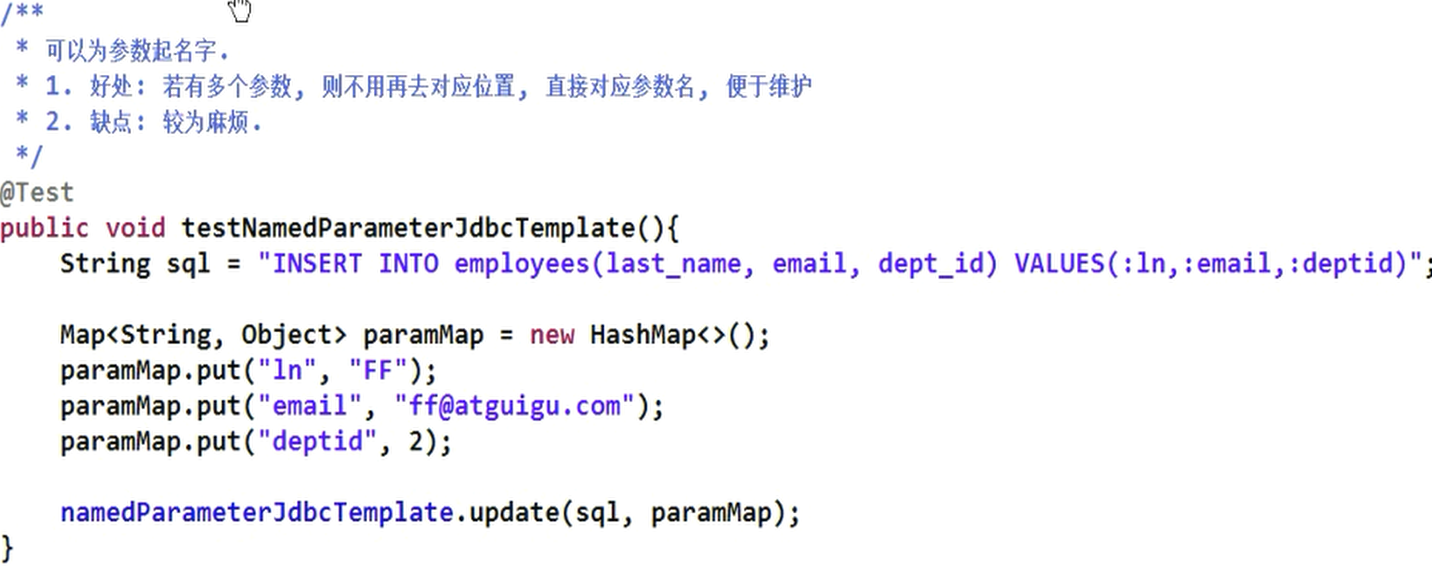连接数据库 首先导入jar包

然后创建properties.xml文件
<?xml version="1.0" encoding="UTF-8"?>
<beans xmlns="http://www.springframework.org/schema/beans"
xmlns:xsi="http://www.w3.org/2001/XMLSchema-instance"
xsi:schemaLocation="http://www.springframework.org/schema/beans http://www.springframework.org/schema/beans/spring-beans.xsd">
<bean id="dataSource" class="com.mchange.v2.c3p0.ComboPooledDataSource">
<property name="user" value="root"></property>
<property name="password" value="1234"></property>
<property name="driverClass" value="com.mysql.jdbc.Driver"></property>
<property name="jdbcUrl" value="jdbc:mysql://localhost:3306/db_person"></property>
</bean>
</beans>
这样就可以使用了
public class Main {
public static void main(String[] args) throws SQLException {
ApplicationContext applicationContext = new ClassPathXmlApplicationContext("bean-properties.xml");
DataSource dataSource = (DataSource) applicationContext.getBean("dataSource");
System.out.println(dataSource.getConnection());
}
}
但是一般不这样做,因为后续维护起来再找比较麻烦,所以将properties属性放入一个专有的db.properties文件中,再引用
user=root password=1234 driverClass=com.mysql.jdbc.Driver jdbcUrl=jdbc:mysql://localhost:3306/db_person
可通过 <context:property-placeholder> 元素简化:
<beans> 中添加 context Schema 定义
在配置文件中加入如下配置:![]()
<?xml version="1.0" encoding="UTF-8"?>
<beans xmlns="http://www.springframework.org/schema/beans"
xmlns:xsi="http://www.w3.org/2001/XMLSchema-instance"
xmlns:context="http://www.springframework.org/schema/context"
xsi:schemaLocation="http://www.springframework.org/schema/beans http://www.springframework.org/schema/beans/spring-beans.xsd http://www.springframework.org/schema/context http://www.springframework.org/schema/context/spring-context.xsd">
<!--导入资源文件-->
<context:property-placeholder location="classpath:db.properties"/>
<!--配置C3P0数据源-->
<bean id="dataSource" class="com.mchange.v2.c3p0.ComboPooledDataSource">
<property name="user" value="${jdbc.user}"></property>
<property name="password" value="${jdbc.password}"></property>
<property name="driverClass" value="${jdbc.driverClass}"></property>
<property name="jdbcUrl" value="${jdbc.jdbcUrl}"></property>
<property name="initialPoolSize" value="${jdbc.initPoolSize}"></property>
<property name="maxPoolSize" value="${jdbc.maxPoolSize}"></property>
</bean>
<!--配置Spring的JDBCTemplate-->
<bean id="jdbcTemplate" class="org.springframework.jdbc.core.JdbcTemplate">
<property name="dataSource" ref="dataSource"></property>
</bean>
</beans>
连接数据库进行测试更新操作 INSERT UPDATE DELETE
package jdbc;
import org.junit.Test;
import org.springframework.context.ApplicationContext;
import org.springframework.context.support.ClassPathXmlApplicationContext;
import org.springframework.jdbc.core.JdbcTemplate;
import javax.sql.DataSource;
import java.sql.SQLException;
public class JDBCTest {
private ApplicationContext applicationContext = null;
private JdbcTemplate jdbcTemplate = null;
{
applicationContext = new ClassPathXmlApplicationContext("applicationContext.xml");
jdbcTemplate = (JdbcTemplate)applicationContext.getBean("jdbcTemplate");
}
@Test
public void testUpdate(){
String sql = "UPDATE student SET name = ? WHERE id = ?";
jdbcTemplate.update(sql, "niu", 3);
}
@Test
public void test() throws SQLException {
DataSource dataSource = (DataSource) applicationContext.getBean("dataSource");
System.out.println(dataSource.getConnection());
}
}
批量更新操作 INSERT UPDATE DELETE
/**
* 批量更新
*
*/
@Test
public void testBatchUpdate(){
String sql = "INSERT INTO student(name, sex, age) VALUES(?, ?, ?)";
List<Object[]> args = new ArrayList<>();
args.add(new Object[]{"AA", "girl", 23});
args.add(new Object[]{"BB", "boy", 21});
args.add(new Object[]{"CC", "girl", 17});
jdbcTemplate.batchUpdate(sql, args);
}
从数据库获取一条记录,实际得到对应的一个对象

@Test
public void testQueryForObject(){
String sql = "SELECT name, sex, age FROM student WHERE id = ?";
RowMapper<Student> rowMapper = new BeanPropertyRowMapper<>(Student.class);
Student student = jdbcTemplate.queryForObject(sql, rowMapper, 1);
System.out.println(student);
}
获取单个列的值或做统计查询
@Test
public void testQueryForObject2(){
String sql = "SELECT COUNT(id) FROM student WHERE sex = ?";
long count = jdbcTemplate.queryForObject(sql, Long.class, "girl");
System.out.println(count);
}
实际开发时使用

在 JDBC 模板中使用具名参数
具名参数只在 NamedParameterJdbcTemplate 中得到支持

